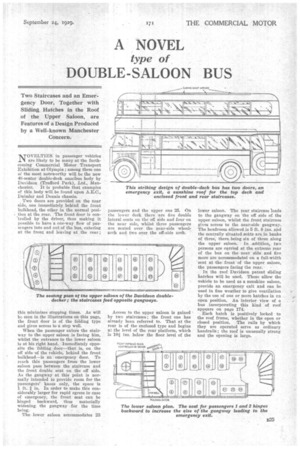A NOVEL
Page 51

If you've noticed an error in this article please click here to report it so we can fix it.
type of
DOUBLE-SALOON BUS
NOVELTIES in passenger vehicles are likely to be many at the forthcoming Commercial Motor Transport Vxhibition at Olympia; among them one of the most noteworthy will be the new 48-seater double-deck omnibus body by Davidson (Trafford Park), Ltd., Mancheater. It is probable that examples of this body will be found -upon A.E.C., Daimler and Dennis chassis.
Two doors are provided on the near side, one immediately behind the front bulkhead, the other in the normal -posi, tion at the rear. The front door is con'trolled by the driver, thus making it Possible to have a one-way flow of passengers into and out of the bus, entering at the front and leaving at the rear ;
this minimizes stopping times. As will be seen in the illustrations onthis page, the front door is of the folding type and gives access to a step well.
When the passenger enters the stairway to the upper saloon is facing him, whilst the _entrance to the lower saloon is at his right band. Immediately opposite the ftdding door—that is, on the off side of the vehicle, behind the front bulkhead—is an emergency door. To reach this passengers from the lower saloon pass between the staircase and the front double seat on the off side. As the gangway at this point is normally intended to provide room for the passengers' knees only, the space is 1 ft. in. In order to make this considerably larger for rapid egress incase of emergency, the front seat can be hinged backward, thus materially widening the gangway for the time being.
The lower saloon accommodates 23
passengers and the upper One 25. On the lower deck there. are -five double lateral seats on the off side and four on the near side, whilst three passengers are seated over the near-side wheelarch and two over the off-side arch.
Access to the upper saloon is gained by two staircases ; the front one has already been referred to. That at the rear is of the enclosed type and begins at the level of the rear platform, which is 101 ins. below the floor level of the lower saloon. The rear. staircase leads to the gangway on the off side of the upper saloon, whilst the front staircase gives access to the near-side gangway. The headroom allowed is 5 ft. 8 ins and the centrally situated.schts are in banks of three, there being six of these along the upper saloon. In addition, two persons are carried at the extreme rear of the bus on the near side and five more are accommodated 'on a full-width seat at the front of the upper saloon,
the passengers facing the rear.
In the roof. Davidson patent sliding hatches will be used. These allow the vehicle to be used as a sunshine saloon, provide an emergency exit and can be used in line weather to give ventilation by the use of one or more hatches in an open position. An interior view of a bus incorporating this kind of roof appears on page 174.
Each hatch is positively locked to the roof frame, whether in the open or closed position. The rails by which they are operated serve as ordinary handrails ; the roof is unusually strong and the opening is large.




















































































































